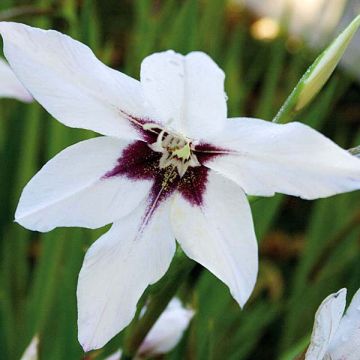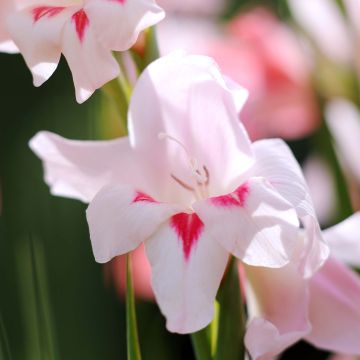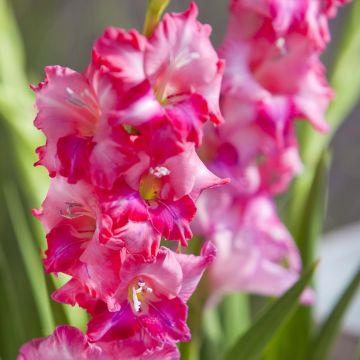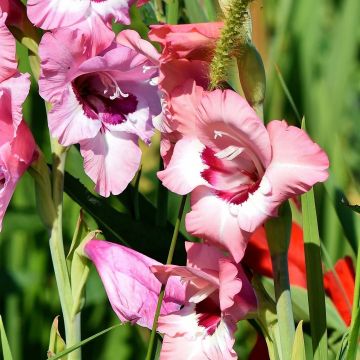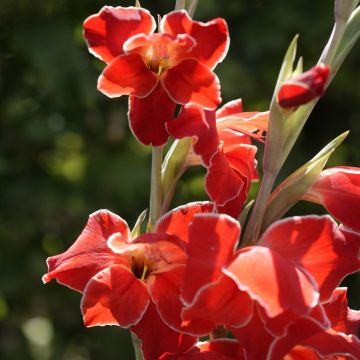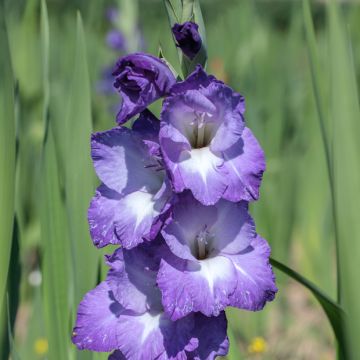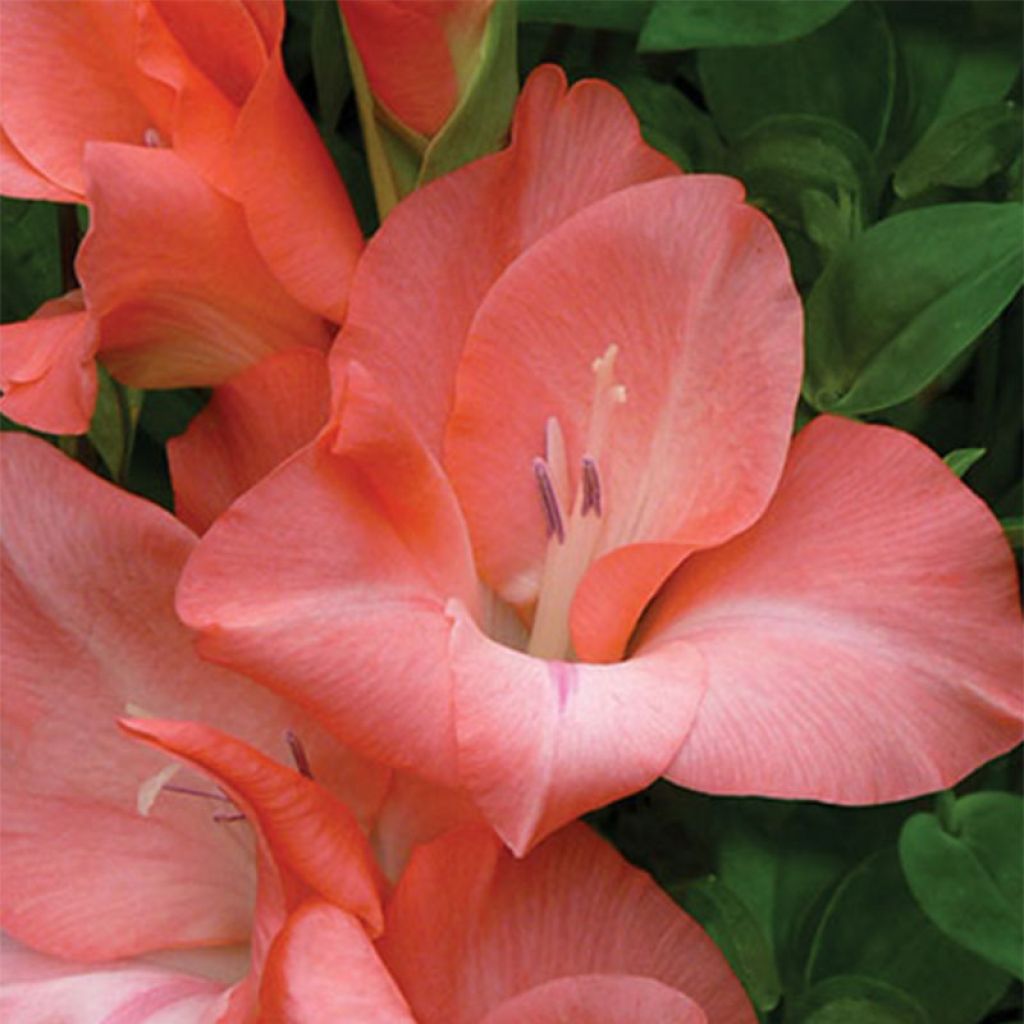

Glaïeul ou Gladiolus Spic & Span
Gladiolus Spic & Span - Sword Lily
Gladiolus x grandiflorus Spic & Span
Large-Flowered Gladiolus, Sword Lily
Very beautiful blooming
Dorothee, 08/10/2021
This item cannot be shipped to the selected country
Delivery charge from €5.90
More information
Schedule delivery date,
and select date in basket
This plant carries a 6 months recovery warranty
More information
We guarantee the quality of our plants for a full growing cycle, and will replace at our expense any plant that fails to recover under normal climatic and planting conditions.
From €5.90 for pickup delivery and €6.90 for home delivery
Express home delivery from €8.90.

Does this plant fit my garden?
Set up your Plantfit profile →
Description
Gladiolus 'Spic and Span' is an old variety that is still widely cultivated for cut flowers. It captivates with the soft and pure salmon pink colour of its large flowers, which bloom on tall, vertical flower spikes. Stunning and long-lasting in a vase, the majestic spikes of gladioli also bring height and elegance to perennial and annual flower beds. The flowers open in groups of 10 to 12 simultaneously, from the bottom to the top of the spike, for about 2 weeks.
Originating from Africa, Europe, and the Middle East, and belonging to the Iris family, the most colourful gladiolus species come from South Africa. Cultivated gladioli are hybrids with large flowers and are divided into 3 main groups: Grandiflorus (large-flowered), Primulinus, and Nanus (butterflies). 'Spic & Span', registered in 1955, belongs to the Grandiflorus group. It is a perennial herbaceous plant with corms and broad sword-shaped leaves arranged in a fan, forming a clump about 1m (3ft) tall, depending on the growing conditions. Flowering occurs in summer, from July to September, depending on the planting date. Solid flower spikes emerge from the soil, well above the foliage. At the top, they bear a spike-like inflorescence with funnel-shaped flowers measuring 10cm (4in) in diameter, tightly packed and distributed almost all around the stem. There are about 18 to 20 flowers, beautifully fringed along the edges and a soft coral pink with a slightly lighter throat.
Gladioli and their long, often flamboyant flower spikes are reminiscent of the 70s and somewhat formal floral arrangements. While they are irreplaceable in bouquets, in gardens their silhouette needs the presence of plants with lush or, conversely, delicate foliage to enhance their somewhat dense flowering. Plant them in groups in beds with salvias, small grasses, linear-leaved plants, baptisias, cloves, and forget-me-nots to create large colourful displays. They are commonly found in kitchen gardens. For cut flowers, cut the flower spikes when the first floret starts to open. Plant them at intervals of two weeks from early spring until the end of June to have flowers throughout the summer in your home and garden.
For your bouquets: pick gladioli that have opened two or three flowers, early in the morning. Leave 5 to 6 leaves per stem to allow the bulb to continue developing. Remove the first two buds at the top of the flower spike. Plant them every ten days in March/April. This way, you will have flowers all summer long.
The gladiolus gets its name from the shape of its sword-like leaves, derived from the Latin word "gladius." Its wild forms were often represented in jewellery or on rugs and fabrics made by the Semitic people before the Christian era.
We deliver them in large size 14+ bulbs, guaranteeing the best flowering.
Report an error about the product description
Gladiolus Spic & Span - Sword Lily in pictures
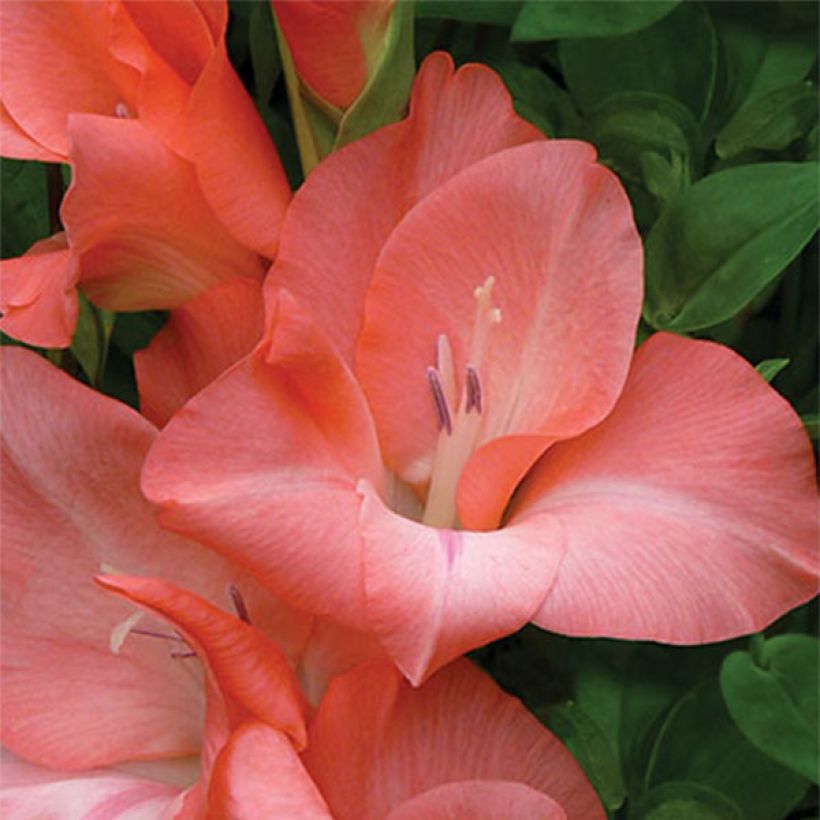

Plant habit
Flowering
Foliage
Botanical data
Gladiolus
x grandiflorus
Spic & Span
Iridaceae
Large-Flowered Gladiolus, Sword Lily
Cultivar or hybrid
Other Gladioli
Planting and care
Gladioli hybrids prefer rich, fertile, well-drained, preferably sandy soil. Plant in full sun and space the bulbs or corms 10 to 15cm (4 to 6in) apart, covered with 10cm (4in) of soil. Feed after cutting the flowers. Avoid using manure, as it promotes bulb rot. Gladioli are susceptible to frost, so they should be dug up when they have withered or immediately after the first frost. Cut the leaves and allow them to dry in a well-ventilated place for three weeks. Separate the old bulbs. Store the new bulbs and bulblets throughout the winter in a cool place, protected from frost. The bulblets will flower in two years.
Planting period
Intended location
Care
-
, onOrder confirmed
Reply from on Promesse de fleurs
Haven't found what you were looking for?
Hardiness is the lowest winter temperature a plant can endure without suffering serious damage or even dying. However, hardiness is affected by location (a sheltered area, such as a patio), protection (winter cover) and soil type (hardiness is improved by well-drained soil).

Photo Sharing Terms & Conditions
In order to encourage gardeners to interact and share their experiences, Promesse de fleurs offers various media enabling content to be uploaded onto its Site - in particular via the ‘Photo sharing’ module.
The User agrees to refrain from:
- Posting any content that is illegal, prejudicial, insulting, racist, inciteful to hatred, revisionist, contrary to public decency, that infringes on privacy or on the privacy rights of third parties, in particular the publicity rights of persons and goods, intellectual property rights, or the right to privacy.
- Submitting content on behalf of a third party;
- Impersonate the identity of a third party and/or publish any personal information about a third party;
In general, the User undertakes to refrain from any unethical behaviour.
All Content (in particular text, comments, files, images, photos, videos, creative works, etc.), which may be subject to property or intellectual property rights, image or other private rights, shall remain the property of the User, subject to the limited rights granted by the terms of the licence granted by Promesse de fleurs as stated below. Users are at liberty to publish or not to publish such Content on the Site, notably via the ‘Photo Sharing’ facility, and accept that this Content shall be made public and freely accessible, notably on the Internet.
Users further acknowledge, undertake to have ,and guarantee that they hold all necessary rights and permissions to publish such material on the Site, in particular with regard to the legislation in force pertaining to any privacy, property, intellectual property, image, or contractual rights, or rights of any other nature. By publishing such Content on the Site, Users acknowledge accepting full liability as publishers of the Content within the meaning of the law, and grant Promesse de fleurs, free of charge, an inclusive, worldwide licence for the said Content for the entire duration of its publication, including all reproduction, representation, up/downloading, displaying, performing, transmission, and storage rights.
Users also grant permission for their name to be linked to the Content and accept that this link may not always be made available.
By engaging in posting material, Users consent to their Content becoming automatically accessible on the Internet, in particular on other sites and/or blogs and/or web pages of the Promesse de fleurs site, including in particular social pages and the Promesse de fleurs catalogue.
Users may secure the removal of entrusted content free of charge by issuing a simple request via our contact form.
The flowering period indicated on our website applies to countries and regions located in USDA zone 8 (France, the United Kingdom, Ireland, the Netherlands, etc.)
It will vary according to where you live:
- In zones 9 to 10 (Italy, Spain, Greece, etc.), flowering will occur about 2 to 4 weeks earlier.
- In zones 6 to 7 (Germany, Poland, Slovenia, and lower mountainous regions), flowering will be delayed by 2 to 3 weeks.
- In zone 5 (Central Europe, Scandinavia), blooming will be delayed by 3 to 5 weeks.
In temperate climates, pruning of spring-flowering shrubs (forsythia, spireas, etc.) should be done just after flowering.
Pruning of summer-flowering shrubs (Indian Lilac, Perovskia, etc.) can be done in winter or spring.
In cold regions as well as with frost-sensitive plants, avoid pruning too early when severe frosts may still occur.
The planting period indicated on our website applies to countries and regions located in USDA zone 8 (France, United Kingdom, Ireland, Netherlands).
It will vary according to where you live:
- In Mediterranean zones (Marseille, Madrid, Milan, etc.), autumn and winter are the best planting periods.
- In continental zones (Strasbourg, Munich, Vienna, etc.), delay planting by 2 to 3 weeks in spring and bring it forward by 2 to 4 weeks in autumn.
- In mountainous regions (the Alps, Pyrenees, Carpathians, etc.), it is best to plant in late spring (May-June) or late summer (August-September).
The harvesting period indicated on our website applies to countries and regions in USDA zone 8 (France, England, Ireland, the Netherlands).
In colder areas (Scandinavia, Poland, Austria...) fruit and vegetable harvests are likely to be delayed by 3-4 weeks.
In warmer areas (Italy, Spain, Greece, etc.), harvesting will probably take place earlier, depending on weather conditions.
The sowing periods indicated on our website apply to countries and regions within USDA Zone 8 (France, UK, Ireland, Netherlands).
In colder areas (Scandinavia, Poland, Austria...), delay any outdoor sowing by 3-4 weeks, or sow under glass.
In warmer climes (Italy, Spain, Greece, etc.), bring outdoor sowing forward by a few weeks.

































